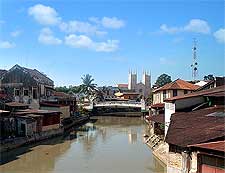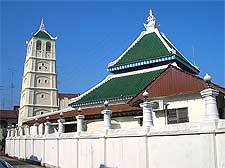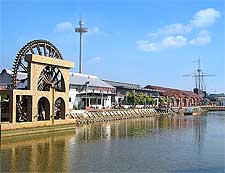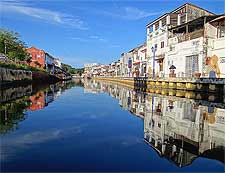Malacca City History Facts and Timeline
(Malacca / Melaka City, Malaysia)

A mish-mash of colonial influences from a succession of European powers, the history of Malacca is revealed in monuments and buildings dotted throughout the city. In fact its heritage is rich enough that it was designated a UNESCO World Heritage site in 2008.
Prior to the 14th century, the area remained untouched by outside influences. All that stood here was a small fishing village inhabited by local Malays.
The Sultanate of Malacca
Around the year of 1400, the serenity of this strip of coast was brought to a juddering halt by the last Raja of Singapura, Parameswara, who established a port in Malacca because it was a strategically important spot halfway down the peninsula. He named the town 'Melaka' after the Malay word for the trees that still grow here today.
Mass immigration from
China saw a rapidly expanding population develop on and around the area still known as Chinese Hill, where a large cemetery remains. As Malacca grew, so did its influence over the rest of the southern portion of the peninsula. Trade soared and the Sultanate prospered as a result.

Portuguese Settlement
Just over a century later, in 1511, Malacca fell to Portuguese invaders travelling from
Goa in
India. This started a cycle of nearly 450 years of colonial rule during the history of Malacca, resulting in its varied heritage still in evidence today. The fort of A Fomosa, whose only remaining structure is the Porta de Santiago, became the centre of Portuguese rule here, built on a hill overlooking the sea to defend the town from the armies of the Sultan. However, it was another European power that proved the main threat.

Dutch Era
The Dutch invaded and took over in 1641, again leaving their distinctive European mark on Malacca. Stadthuys, or the Red Building, was built in 1650 on Laksamana Road and is today the oldest Dutch structure still standing in the East.
In its day the building served as the official residence of the Dutch governor. The building is today an intriguing museum-type attraction, containing a wealth of artifacts and clothing from the area, and is the best place to take a more detailed look at Malacca's turbulent history. Close by and still standing is Christ Church, another fine example of Dutch architecture built in the middle part of the 18th century.

Under the British Empire
By 1824, the Dutch had essentially lost interest in Malacca and began to concentrate their efforts on Indonesia instead, ceding the colony to the British under the Anglo-Dutch Treaty. The British East India Company ruled until 1946, before the town became a crown colony.
During this period, the British did little building of their own, instead converting the existing Dutch and Portuguese buildings for their own use, even painting the Stadthuys its distinctive red colour. The Memorial Hall, built by the British in 1912, became a symbol of the new Malaysia when the first prime minister announced the country's independence here in 1957. The site is now a museum dedicated to the history of Malacca and Malaysian independence.
Nowadays, Malacca boasts more museums per square mile than anywhere else in Malaysia. These include the quirky, unrelated to actual history in Malacca, yet the city itself is a living history experience as you wander from the old Chinese quarter to the Colonial hill, and onwards to a modern mall nearby.
Venture into the suburbs and you will discover plenty of evidence of its past on the various small hills inland, including fortifications and ancient gravestones.
 A mish-mash of colonial influences from a succession of European powers, the history of Malacca is revealed in monuments and buildings dotted throughout the city. In fact its heritage is rich enough that it was designated a UNESCO World Heritage site in 2008.
A mish-mash of colonial influences from a succession of European powers, the history of Malacca is revealed in monuments and buildings dotted throughout the city. In fact its heritage is rich enough that it was designated a UNESCO World Heritage site in 2008.

